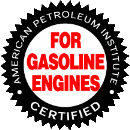|
Taking the Mystery out of Engine Oil |
||||||||||||||||||||||||||||||||||||||||||||||||||
| A guide to all it does, and how it does it. | ||||||||||||||||||||||||||||||||||||||||||||||||||
| The more we know about engine oils, the more wisely we can | ||||||||||||||||||||||||||||||||||||||||||||||||||
| choose the best oil for our cars and trucks. | ||||||||||||||||||||||||||||||||||||||||||||||||||
| Engine oils do more than you think | ||||||||||||||||||||||||||||||||||||||||||||||||||
| It's easy to name the main function of engine oil: to lubricate every | ||||||||||||||||||||||||||||||||||||||||||||||||||
| moving part of your engine with a protective film that reduces friction. | ||||||||||||||||||||||||||||||||||||||||||||||||||
|
But engine oil has at least four other duties, and failure to perform them all can seriously reduce the performance and life of your engine. First, your engine oil cleans your engine. Gasoline and diesel engines can produce soot, ash, acids, and moisture which form sludge, varnish, and resins. If they collect on critical engine parts, it means serious trouble. A quality engine oil keeps them suspended until filtered out or drained away when you change your oil. Next, oil seals microscopic hills and valleys on piston rings and cylinder walls. Without proper sealing action, you'll lose power and waste fuel. Engine oil also protects your engine against rust and corrosion. Finally, oil cools vital parts such as camshaft, rods, and pistons that the engine coolant in your radiator cannot reach. As much as 40% of the cooling job in your engine is performed by the oil in your crankcase. Making it easy to choose the proper oil for your car.Look For The
STARBURST The API Certification Mark, also called the "Starburst", is found on the front label of most high quality passenger car engine oils made in North America. With so much depending on your oil's performance, it's important to select the right oil for your engine's needs. The American Petroleum Institute (API) Certification Mark identifies oils which have passed a comprehensive series of performance tests and performance audits. These tests verify the ability of the oil to perform vitually every task expected of it in your engine, from minimizing engine wear to preventing corrosion and the build-up of deposits. By choosing oil with the API Certification Mark, you can extend the life of your engine, reduce the chance of engine failure, and help maintain emission standards to fight pollution. API Certified engine oils are recommended for passenger car engine in most parts of the world. In Europe, a different system is used for passenger car oils and the same is true for heavy duty truck engine oils everywhere. How to read an engine oil label
|
| ACEA Category | Type of Engine | Performance Level |
| A1-96 | Passenger Car Gasoline | Fuel Economy Oil |
| A2-96 | Passenger Car Gasoline | Moderate Performance |
| A3-96 | Passenger Car Gasoline | High Performance |
| B1-96 | Passenger Car Diesel | Fuel Economy Oil |
| B2-96 | Passenger Car Diesel | Moderate Performance |
| B3-96 | Passenger Car Diesel | High Performance |
| E1-96 | Heavy Duty Diesel | Moderate Performance |
| E2-96 | Heavy Duty Diesel | High Performance |
| E3-96 | Heavy Duty Diesel | Super High Performance |
Cold facts about viscosity index
The Viscosity Index or VI measures the change of an oil's viscosity over a wide range of temperatures. The higher the VI of an oil, the less it will thicken when cold, and the less it will thin out when hot. A high VI oil will be more effective when lubricating your engine over a wide temperature range. Changes in viscosity and VI result in different viscosity grades, so you can pick the best grade for your vehicle. Here's a description of the five most common SAE multi-grade oils:
| 0W-30 | Premium winter grade oil. Provides year-round protection and fuel economy. Can be used where SAE 5W-30 is recommended. |
|---|---|
| 5W-30 | Premium multi-grade oil for easier cold-weather starts, maximum protection, excellent fuel economy and added engine life. The preferred grade for most cars built after 1989. |
| 10W-30 | The best selling premium multi-grade in North America. Delivers excellent all-round performance for the average driver. |
| 10W-40 | A premium multi-grade oil for hotter-than-normal running conditions. May provide extended engine life under high temperature conditions. |
| 20W-50 | Thicker premium multi-grade oil for added protection against metal-to-metal contact; specially formulated to meet the needs of high performance European engines. |
Making a change for the better
Today's engines are efficient and sophisticated machines, often using multiple camshafts, turbo-chargers and other features. They also run faster and hotter, placing tremendous demands on engine oil performance.
That's why it is essential to follow a strict oil-and-filter change schedule for your car. Changing the oil and filter remove harmful contaminants that may build up in your oil.
A fresh supply of engine oil with its specially selected additives will restore the protection your engine needs against corrosion, gum deposits, excessive wear, and other problems.
The oil and filter should be changed at the interval recommended in your owner's manual. Every 5000 km or 3 months is a common recommendation in North America. Every 15,000 to 20,000 km is more common in Europe.
Speaking of performance additives
Most oils look, feel, and smell the same but their performance can be vastly different, thanks in part to additives. Additive suspend dirt, inhibit foam, improve cold-weather flow, prevent corrosion, reduce friction, and add other qualities.
Many specialty additives or oil treatments are sold separately as brand names and promise longer life or extra performance for your engine. Remember that modern oils are recipes with measured portions of ingredients. Upsetting the recipe balance could lead to problems.
An oil formula may include a little anti-wear additive the same way a cake includes a pinch of salt to bring out flavour. If a little salt works, should you add more? Probably not, and the same goes for oil additives.
We believe choosing the best quality oil you can afford and changing it according to your owners manual is wiser in the long run.
Promoting your car's engine and the environment
Premium engine oils such as Petro-Canada Supreme aid the environment by helping your car's engine maintain peak performance with minimal emissions. If you change your oil yourself, please continue to help....
- Don't dump used oil on the ground, down drains or in sewers, and don't mix it with any other liquid.
- Do place used oil in a clean plastic container with a secure lid and take it to a collection point for disposal or recycling.
In many ways, the only thing you need to remember about engine oil is to look for the Petro-Canada symbol !

